 Nuclear-powered ballistic missile submarines (1958-61), service 1959-1985: USS George Washington, Patrick Henry, Theodore Roosevelt, Robert E. Lee, Abraham Lincoln (SSBN-598 to 602)
Nuclear-powered ballistic missile submarines (1958-61), service 1959-1985: USS George Washington, Patrick Henry, Theodore Roosevelt, Robert E. Lee, Abraham Lincoln (SSBN-598 to 602)Cold War US Subs
GUPPY | Barracuda class | Tang class | USS Darter | T1 class | X1 class | USS Albacore | Barbel classUSS Nautilus | USS Seawolf | Migraine class | Sailfish class | Triton class | Skate class | USS Tullibee | Skipjack class | Permit class | Sturgeon class | Los Angeles class | Seawolf class | Virginia class
Fleet Snorkel SSGs | Grayback class | USS Halibut | Georges Washington class | Ethan Allen class | Lafayette class | James Madison class | Benjamin Franklin class | Ohio class | Colombia class

The George Washington class were the first nuclear-powered ballistic missile submarines deployed by the United States Navy, a class derived frolm the Skipjack class SSN to gain time (essentially stretched to fit missile silos) which with the later Ethan Allen, Lafayette, James Madison, and Benjamin Franklin classes made the “41 for Freedom” group of naval deterrence until the late 1980s. There were only five of these “boomer” but they were given very special names commeting in prestige with supercarriers and the tradition went on until reverting to state names under the Reagan administration, which was a former battleship (and nuclear powered cruiser) tradition. The full story. #ussgeorgeswashington #usnavy #unitedsttesnavy #ssbn #strategicsubmarines #usdeterrence #polaris #coldwar
Development
The Regulus Program, nuclear SSGNs

USS Growler and its Regulus I missiles
In 1950, the US Navy starting looking at submarines to partake the nuclear deterrent role, competing with the USAF. The latter had the privilege of transcontinental heavy bomber (with the B36 peacemaker and B-52), and the Navy worked on the concept of smaller bombers that can take off from its carrier decks. Experiments were made notably with the Neptune from its supercarriers, but this was contested by the USAF and notably the powerful chief of SAC (Strategic Air Command), Curtis LeMay. The latter won the match, leading to the cancellation of the dedicated strategic carrier USS United States and later developed models such as the AJ Savage and Vigilante, the concept never took off (without pun) mostly for political reasons. On the other hand, the submariners faction in the Navy started to work with the early missile depertment of the Navy in ways to fit cruise missiles (nuclear tipped) on ramps that could be fitted in submarines. The aicraft carrier was a large and visible target which needed to close ton target to launch its aircraft, whereas a submarine could sneak in close to enemy shores, fire and disappear.

USS Halibut, the last strategic SSGN in the US Navy. She launched on 9 January 1959, a few months before USS Georges Washington (9 June)
The submarine faction obtained to convert a serie World War II vintage diesel-electric boats (Gato class) for such experiment. They were large, recent and in no shortage. USS Tunny and USS Barbero were thus the first converted to carry Regulus cruise missiles and thus, started the concept of deterrent patrols. Next, they were joined by the first purpose built diesel boats with such missiles, the Grayback class, followed by the first nuclear powered SSGN (which stands for Sub-Surface, Guided, Nuclear), USS Halibut. All the five boats used Regulus in the deterrent role, but the missile had serious limitations as it was vulnerable to interception by fighters, being large and with a predictible path, subsonic and with a range of less than 1000 km making the carrier submarine approaching dangerously close to enemy waters and surface to launch them, with the long preparation time nearly stopped, exposing them further. Plus, only a few missiles could be carrier at once, as the large USS Halibut class only could carry five missiles. To add insult to injury, the missiles were a guided by a radio signal which needed to be transmitted wiothout interruotion from the carrier submarine, or a ship or aircraft, equally exposed, or a ground station. It was understood the future was in ballistic missiles, which were “suntoppable” due to their trajectory. Plus launch methods and guidance could be improved.

The Soviet Hotel class (Project 658). Completed in 1961-62 and with only three missiles meant the Soviet Union lost the race there already. The first equivalent to the 1st US generation of SSBNs was the Yankee class (Project) commissioned from 1967 onwards. The USN at the time already had the Lafayette class, arguably 2nd generation SSBNs.
A race between superpowers for the first SSBN
There was in addition a race between superpowers there. Stalin had the bomb in 1949, Both developed intercontinental bombers, and worked on ways to deliver these from sea platforms a well. The Soviet Navy both developed SSGNs and SSBNs, but was late to create efficient ballstic missile launching submarines. In the late 1950s the Soviet fleet already had a few transformed Whiskey class diesel subs with cruise missiles (the “bin” serie), embarked on the diesel-powered Golf class first (launched 1957), which had three missiles in the sail and the nuclear powered Hotel class launched 1959. But when completed, the US had won the race already. Completed earlier, the Georges Washington class were far better propositions with their 16 hull-mounted missiles, launched underwater. USSR had nothing of the kind yet, and made it in numbers what it lacked in quality.
The true genesis of the Georges Washington class, the first American SSBNs (the B stands for ballistic here), and i will not dwelve into the long genesis of nuclear power here (see USS Nautilus and development by Hyman Rickover), nor the incremental steps to improved underwter surface speed and stealth (see the Albacore here) but when they appear, the Skipjack class combined the teadrop hull shape with nuclear power and a new generation, really advanced detection system to make them the perfect SSNs at the time. There was a no-brainer as a good base design. Still, the development of a SSBN required a ballistic missile program for the Navy and the design was finalized in a record four years.
The Polaris Program
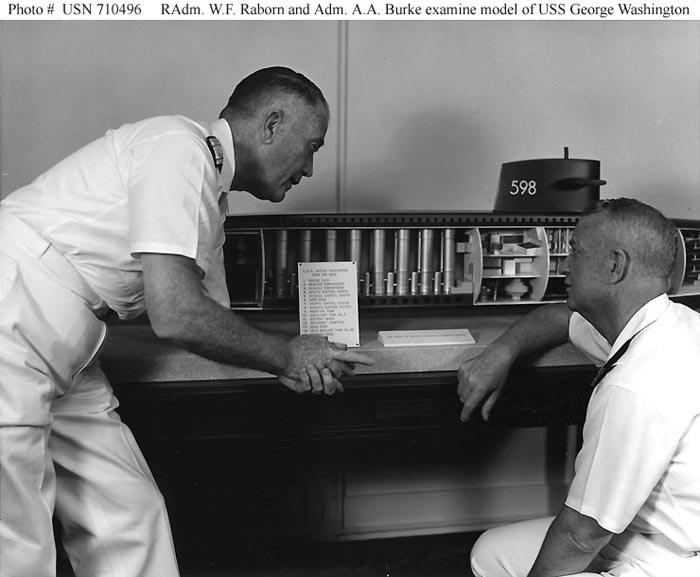
Admiral W.F. Raborn presents to CNO Arleigh A. Burke the official model of the new class.
The Navy initially worked on a sea-based variant of the US Army “Jupiter”. This was an intermediate-range ballistic missile. It was large and thus it was envisioned to carry four tubes only, likely installed in the sail, all being liquid-fueled missiles. Rear Admiral W. F. “Red” Raborn was appointed by the current Chief of Naval Operations Admiral Arleigh Burke in late 1955. His role was to create a Special Project Office to further develop Jupiter into a Naval missile. However meanwhile, Project Nobska submarine warfare conference in 1956. Among the most notable speakers was physicist Edward Teller of the Manhattan program fame, which declared that a compact one-megaton warhead could still be produced and compacted into a solid-fueled Polaris missile, a project he led at the time. The latter being far more compact, it offered more interesting development prospects.
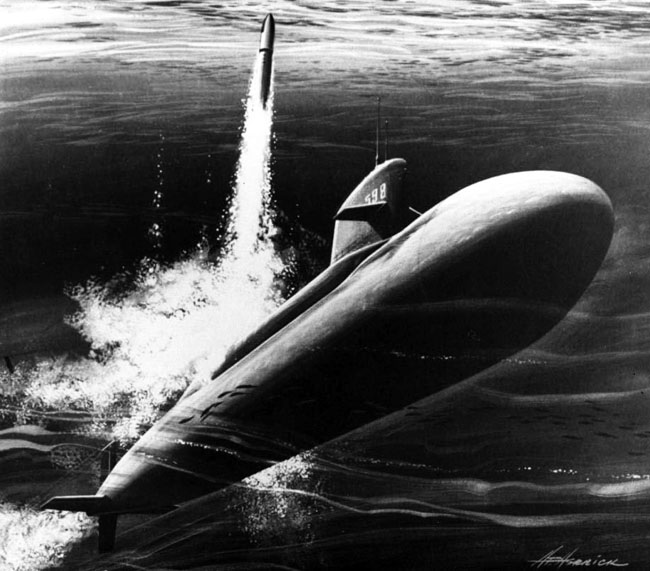
Commemorative drawing of the first historical launch in 1960
This prompted the Navy to leave the Jupiter program by December (to the dismay of the army, as the Navy took its share of the development). Admiral Burke then concentrated all Navy strategic research teams on the Polaris alone, which was done in Admiral Raborn’s Special Project Office.
There were garnatuans issues to solve, such as the the submerged launch, and a more compact design thay would have allowed the missiles to be carried in a more compact hull instead as in the sail, a solution that posed mukltiple problems, notably of trim as the Soviet discovered.
This allowed also to go as far as 16 missiles, since the silos could now be simply multiplied behind the sail. But launching underwater (a firm prerequisite in 1955) demanded precise navigation for accurate missile targeting. Working by shifts around the clock for four years, from 1955 to 1958, as the design was still refined, Raborn program succeeded, to the admiration of Burke and congratulations later of Eisenhower for such a feat of engineering. The problems solved here would require almost a decade for the Soviets.
Design and Construction
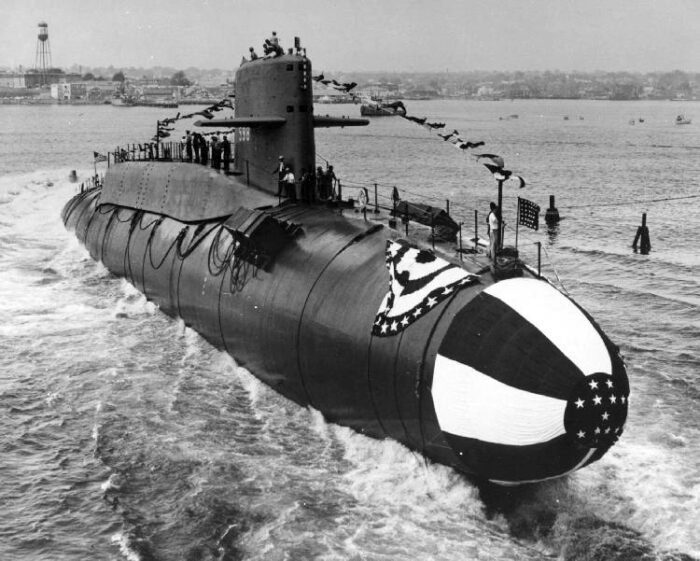
The real impetus to develop the boat was not to wait for trials of the Polaris to be completed and instead the usual process of going back and forth between the admiralty board (BuOrd) and BuShips, the former directly ordered a class of nuclear-powered submarines which could hold the first version of the underwater missile rube designed by the team behind the Polaris, on 31 December 1957. Instead of doing the usual competition between yard trials, went directly to Electric Boat, the most experienced sub builder in the US at the time, in order to convert two existing attack submarine hulls and make them ballistic missile-carrying boats so to have a submarine deterrent force as soon as practicable.
To accomplish this conversion, Electric Boat went back to the admiralty board that its latest design, the Skipjacks was to be piccked up for conversion in January 1958, and to slip launch dates for two of these Skipjack class fast attack submarine: USS Scorpion (SSN-589) and the ordered but no laid down USS Sculpin (SSN-590). Meanwhile, the lead boat USS Skipjack has been already laid down on 29 May 1956, and launched on 26 May 1958. It was too late at that stage for a conversion. Only USS Scoprion needed changes, and by 12 February, President Dwight D. Eisenhower authorized funding for three of these conversions, meaning Electric Boat was to provide a new one as well. At the same time, names were discussed, as the tradition of fish names seemed not grand enough for this new type of earth shattering submarine.
It was understood that USS Scorpion (which was completed as a Skipjack class nonetheless, only being SSN-589 instead) would be renamed, and back and forth dicussions withing the naval staff and politicians, including a final word by the President, and the most obvious to all, to underline the role of the new submarine, was to take significant presidents names. Until then, there has not been many ships named that way, but a frigate (1798) purchased on 12 October for the quasi war and having four years of service, and then ID-3018 a German ocean liner launched in 1908, taken over and converted as transport by the US Navy during World War I as she was in the US in 1917. She was sold for scrap in 1951. The name was thus free since a few years, and apart a new supercarrier (which names drew from the old superfrigates of the erly days of the USN), it seemed fitting to all.
Thus, USS Georges Washington was converted on slip, not yet launched, and SSBN-598 was rebuilt from the nearly launched USS Scorpion. Her hull was laid down twice in fact, as her original hull was redesigned to include a brand new section containing all eight sections of two missile silos each, to be installed aft of the sail. The whole fore and aft section were separated and pushed either side. The original Skipjacks were indeed measured 76.71 meters long overall (251 ft 8 in) for 9.6457 meters in diameter (9.6457 m).
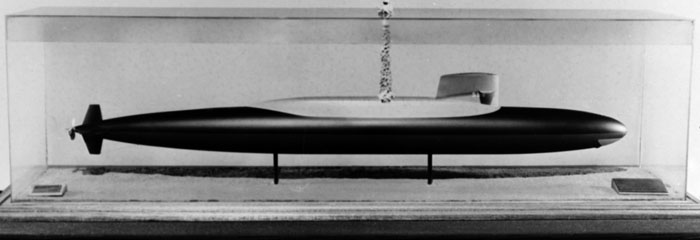
Official model, depicting the ship firing a Polaris A-1 missile, national archives.
The new boats would be much longer, at 381.6 ft long overall (116.3 meters) four a rounded 33 ft (10 m) in beam. USS Sculpin was also converted, becoming USS Patrick Henry (another central independence figure) with a new hull being laid down entirely and a single date. The material for building USS Scamp was also diverted for the third boat, USS Theodore Roosevelt, which delayed her own construction, not at Electric Boat but Mare Island Naval Shipyard, Vallejo, California. USS Scorpion’s first laying was 1 November 1957 and her two sisters in May 1958. The next two were ordered later FY1959 Robert E. Lee (SSBN-601) but at Newport News Shipbuilding and Drydock Co. in Newport News, Virginia as well as Abraham Lincoln (SSBN-602) Portsmouth Naval Shipyard, Kittery, Maine.
The commissioning of George Washington on 30 December 1959 as as much an event as was the launch ceremony. Thus was indeed the first submarine Polaris submarine and its first missile launch on 20 July 1960, as well as her first deterrent patrol by November 1960 to January 1961 rewards the intense effort provided by all teams involved. Thus truly was day one of US deterrence at sea.
Design of the class
Hull and general design

The Skipjack base hull was just lenghtened, thanks to the insertion of a large ballistic missile section behind the sail, 130 ft (40 m) long. Other changes were to create “shoulders” at the base of the sail to make a seemless transition from the hull to the higher missile bay. This added “hump” was also continued on the latter part of the hull. The reactor was placed aft of the missile bay as well. The rest wa spretty much unchanged to gain time, apart extra berthing for the crew, 112 strong, versus 85 up to 95 on the Skipjack. Later the practice of having two crews on board was started, so the boats ended with 228 men in practice, 24 officers and 200 men in shifting teams. That too, was a pioneering concept the Soviets followed as well.
The new subs were of course much longer ansd thus heavier than the Skipjacks, reaching surfaced 5,959 long tons (6,055 t) and submerged 6,709 long tons (6,817 t) instead of 3000/3500 tonnes, so almost double. This was due in part to the heavier silos and associated missiles, filled with fuel, new trims tanks, etc. The hull had a draft up to 29 ft (8.8 m), and like the Skipjacks, it was painted in two tones, a black upper livery for discretion underwater, and a red hull with the usual navy primer. There were two safety hatches at both ends with an escape room, and three entry hatches. The Command Center was modified to include all the necesary displays for the new missile bay, and if the sail did not changed or its associated masts, there were differences in the way less focus was given to offensive torpedo armament and sensors suites (see later).

The sail of USS Sculpin, essentially the same model was taken unchanged for the Washington class, with the crew able to stand on the two diving planes, accessing from a small door. Also just like for the Skipjacks, periscope masts were camouflaged.
Powerplant
The Washingtons were powered by the same machinery essentially, as the Skipjack, a single S5W Pressurised Water Reactor coupled with two 2 geared steam turbines (15,000 shp (11,000 kW)) which in turned were geared to a single shaft carrying a 7-bladed bronze propeller, of the same model as for the Skipjacks. The design of the cross tail was aso the same. As for performances, giving the extra weight and lenght, they were inferior, but still superior when surfaced at 16 knots (30 km/h) versus 15 knots on the SSN, but only 22 knots (41 km/h) submerged versus 33 knots. 1/3 loss which was not only the result of the underwater bulk and extra displacement, but also changes in the drive transmission to achieve greater autonomy and a safer use rather than top speed as for SSNs.
Range was the same, unlimited except by food supplies, and the use of two crews later opened the possibility of having a crew change not at homeport but directly at any point on the globe, with food and replacement crew brought by ship. Far less agile, the Washington class still had the same hull construction and could reach 700 ft (210 m), the “normal max depth”, with a crushing point calculated at at last twice that point.
Armament
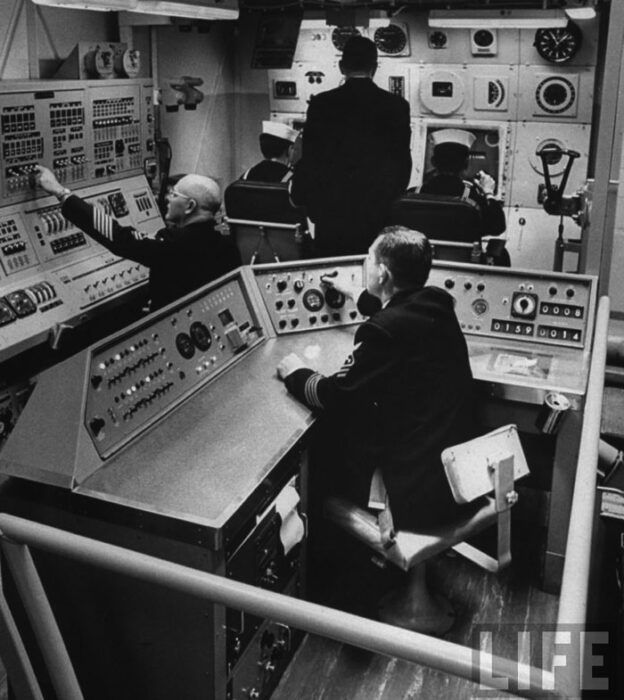
Washington’s Operation Room shot by LIFE Magazine, replicating the future CC installed of these boats. This one was on land, from the training facility at the Submarine Base, Groton, showing the the “Drive and Dive” simulator. Photo: Al Fenn, courtesy of life.time. navsource.
Main
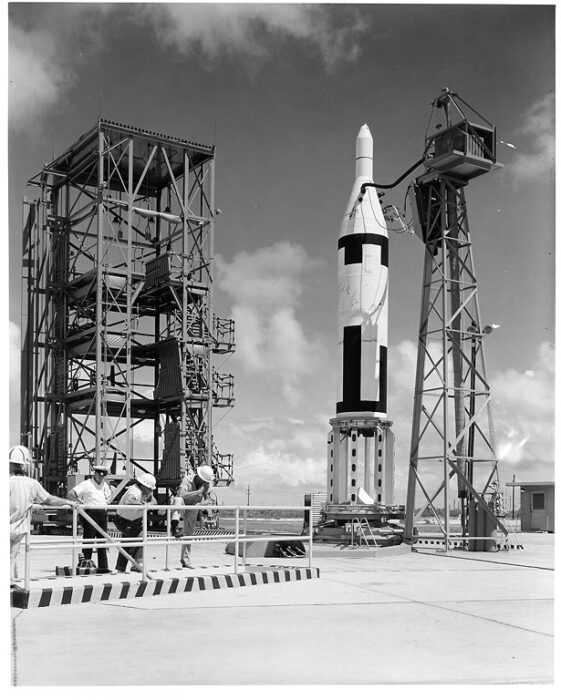
The main hard hitting asset of that class: No less than sixteen UGM-27 ballistic missiles (a world record). Each had a single warhead, carrying a single W47 thermonuclear bomb with its reentry vehicle atop the missile. The Washington class would receive later the version A2. The warhead was developed by the Lawrence Radiation Laboratory in 1957-1960. it was 18 in (460 mm) in diameter, 47 in (1,200 mm) long, 720 lb (330 kg) for the initial Y1 model, with a design yield of 600 kilotons.
When upgraded to Y2 the yeld was ported 1.2 megatons. The W47 was the first warhead with a miniaturized pit and aerodynamic flare for stability during descent. It included even two small rocket motors to spin the warhead and stabilized it as well as its symmetry during reentry, instead of tails, that would have no air to catch. As a result, its CEP or accuracy was of 1,800 meters (5,900 feet), which given the explosion radius was close enough to neuralized the target. It was constantly improved on the A2, and the A3 introduced MIRVs. All could fit into the same silos, allowing to upgrade the Washingtons (see later).
The first generation A1 Polaris ballistic missiles were developed by Lockheed Corporation from 1956, and the design was ready for service in 1960. It went parallel to the Washington class. Each missile weight 35,700 lb (16,200 kg) for an height of 32 ft 4 in (9.86 m) and a diameter of 4 ft 6 in (1,370 mm). Tests were made from Cape Canaveral. In addition to the in-house submarine navigation system for accuracy, engineers provided a ‘Stable Platform’ configuration using a new inertial guidance system.
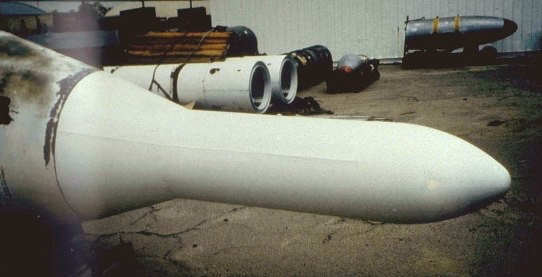
The MIT Instrumentation Laboratory created and provided the Navy its first Inertial Navigation System (SINS) in 1954. But tests showed poor accuracy due to the outdated technology of the gyroscopes used, which needed a serious redesign. The gravest problems were that the initial configuration did not account for change in gravitational fields induced by the submarine itself while in motion, nor the changing position of the Earth. Polaris engineers thus looked at a system abandoned by the U.S. Air Force, the XN6 Autonavigator, initially developed for the Autonetics Division of North American Aviation for the Navaho project.
It was made for air-breathing cruise missiles, but solved the team issues in 1958. More importantly, the pre-GPS era Transit system (later called NAVSAT) was also developed for it. It was developed by physicists at Johns Hopkins’s Applied Physics Laboratory (APL): William Guier and George Weiffenbach from 1958 and completed in 1959.
It was coupled by a computer small enough to fit through a submarine hatch (fior repairs and upgrades) developed in 1958, the AN/UYK-1. It was crucial to interpret Transit satellite data and send guidance information to the missile in its final setup for launch, before cables were disconnected.
The continuous dead reckoning update of the submarine’s position was not fully operational until Transit was introduced in 1964 and later to make it cheaper, the Polaris borrowed the mass-produced microchips similar to the Texas Instruments ones made for the Minuteman II, made by Westinghous and RCA, with a price dropping to just 2 dollars in 1968 per chip.
The Polaris A1 made its maiden flight from Cape Canaveral on September 24, 1958 (AX serie). Studied were initiated at the Lawrence Livermore National Laboratory by a team headed by John Foster and Harold Brown, and the Navy accepted delivery the first 16 warheads in July 1960. The first Polaris I underwater launch was performed on 20 July 1960, with an unset (dead) warhead. On May 6, 1962, a Polaris A-2 with live W47 warhead was tested in the Central Pacific as part of Operation Dominic “Frigate Bird” by USS Ethan Allen (second SSBN serie). This was the first live strategic nuclear missile test.
The Polaris A1 was the model installed on the Washington class, with a range of 1,400 nautical miles (2,600 kilometres) and single Mk 1 re-entry vehicle and its W-47-Y1 thermonuclar wahread, which however had many reliability problems with 1060 Y1 and Y2 produced until retired with just 300 in service. In 1966 they were already to the point of being discarded. It was so bad that it was estimated that 50-75% of warheads would fail if launched. Most of it was due to design issues causing corrosion. To stay in service they were all inspected and internals redone anew.
Now, to put things into perspective, the Soviet’s Hotel class R-13 ballistic missiles (4K50, SS-N-4) were surface launch missiles of 13,700 kg for 11.8 meters in height, 1.3 meters diameter, 650-700 km range only, and CEP of circa 4 km but with an equivalent payload of a megaton…
⚙ specifications Polaris A1 SLBM |
|
| Weight | 35,700 lb (16,200 kg) |
| Dimensions | 31 feet (9.4 m) long and 4.5 feet (1.4 m) in diameter |
| Propulsion | Two solid-fueled stages, reactor |
| Speed | 8,000 mph (13,000 km/h) |
| Range | 1,400 miles (2,200 km) |
| Guidance | Interntial, satellite, see notes. |
| Ceiling | Stratposphere, pre-orbital |
| Accuracy | CEP 1,800 meters (5,900 feet) |
| Payload | W47, 600/1.2 Mgt yeld Y1.Y2 |
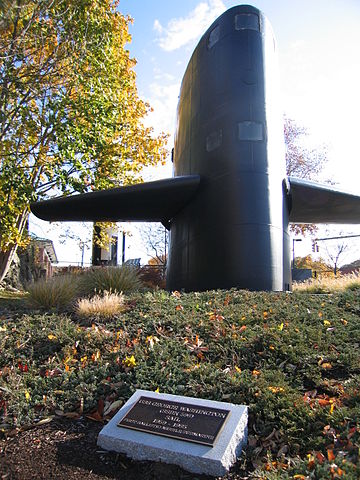 In 1966, George Washington, Patrick Henry, Robert E. Lee and in 1967, Theodore Roosevelt, Abraham Lincoln all had their Polaris A-1 (UGM-27A) replaced by Polaris A-3 (UGM-27C).
In 1966, George Washington, Patrick Henry, Robert E. Lee and in 1967, Theodore Roosevelt, Abraham Lincoln all had their Polaris A-1 (UGM-27A) replaced by Polaris A-3 (UGM-27C).
1981, George Washington, Patrick Henry and in 1982, Robert E. Lee had their Polaris A-3 removed as per SALT treaties. Indeed, by the end of 1979 SALT II imposed the Ohio-class ballistic missile submarine larger missile payloads on shortened patrols of six weeks, and the early SSBNs were ddeactivated, with USS Theodore Roosevelt and Abraham Lincoln offloading their missiles into the brand new Explosives Handling Wharf at Bangor in Washington for disposal. Their missile compartments were removed, decommissioned by the end of 1982 but later in 1983 for USS George Washington, Patrick Henry and USS Robert E. Lee. They were reclassified as attack submarines but due to their speed were soon nicknamed “slow attacks” and only briefly served in Pearl Harbor before decommission. Only George Washington’s sail was preserved at Groton in Connecticut, the “house of submarine” in the USA.
Torpedo Tubes
The point discussed was about deleting the torpedo tubes entirely, but between how to occupy the new space in the bow and redeisgn time it was simply decided to keep all six 21-inch (533 mm) torpedo tubes of the former class where they were, and only halving the torpedo reserve to just 12 torpedoes, so one reload per tube, which seemed more than reasonable. These were Mk 59 tubes, and these were likely the cheap and affordable 1957 Mark 37 torpedoes. Tables below.
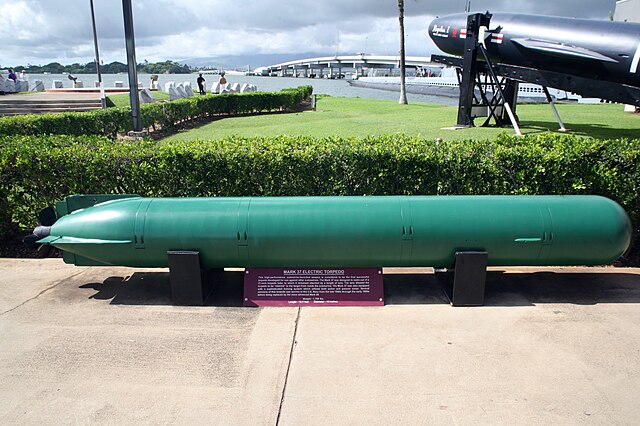
A post-WW II electric acoustic torpedo forst deployed in 1957. The Skipjacks were probably given the 1960 Mark 37 Mod 1, specs below. The 19″ (48.3 cm) Mark 37 and Mark NT37 Designed about 1956 (last introduced, Mod 3: 1967) became the standard US Submarine launched ASW torpedo of the 1960s and until the 1990s.
⚙ specifications Mark 37 TORPEDO |
|
| Weight | 1,660 pounds (750 kg) (mod.1) |
| Dimensions | 161 inches (410 cm) (mod.1) x 19 inches (48 cm) |
| Propulsion | Mark 46 silver-zinc battery, two-speed electric motor |
| Range/speed setting | 23,000 yards (21 km) at 17 knots, 10,000 yards (9.1 km) at 26 knots |
| Warhead | 330 pounds (150 kg) HBX-3 high explosive with contact exploder |
| Max depth | 1,000 feet (300 m) |
| Guidance | Active/passive sonar homing, passive 700 yards (640 m) from target, active and wire-guidance |
Sensors
The SSBNs differed from the SSNs by a least impressive suite, such the absence of a SQS-49 sonar and of a WLR-1 ECM suite. It was never upgraded during their service as far as information goes.
BPS-12 radar
The AN/BPS-12 is a medium-range surface search and navigation radar, modified BPS-5 and similar to the BPS-14 radar. It uses both a periscope antenna and a conventional antenna. Last use on the Skipjach class.
BQS-4A sonar
The BQS-4 was active sonar, here in its latest variant. The AN/BQS-4 is an active/passive detection sonar consisting in the AN/BQR-2 passive detection system and added active detection capability.
The BQS-4 active component comprised seven vertically stacked cylindrical transducers, located inside the BQR-2 chin bow dome to transmit its active “pings.”
In addition to passive listening, it can operate in either automatic echo-ranging or “single-ping” modes.
BQR-2 sonar
The BQR-2 “derived” from GHG in 1960 with a “blue water” range against a snorkelling model at 15-20nm with a bearing accuracy of 0.1 degrees in active mode. It was less in passive mode. The next BQR-4 became the first array sonar developed by the U. S. Navy. from Edo Corp. as an enlarged version of the GHG/BQR-2 sonar. The small BQR-2 array was in a dome beneath the hull.

Author’s rendition

Conway’s profile.
⚙ G Washington class specifications |
|
| Displacement | Surfaced 5,959 long tons, submerged 6,709 long tons |
| Dimensions | 381.6 x 33 x 29 ft (116.3 x 10 x 8.8 m) |
| Propulsion | 1 shaft prop, 1 S5W PWR, 2x GS turbines (15,000 shp (11,000 kW) |
| Speed | 16 knots (30 km/h) surfaced, 22 knots (41 km/h) submerged |
| Range | Unlimited except by food supplies |
| Armament | 16 Polaris A1/A3 missiles, 6 × 21-in (533 mm) TTs (12 torpedoes) |
| Sensors | BPS-12 radar, BQS-4A sonar, BQR-2 sonar |
| Test depth | 700 ft (210 m) |
| Crew | 2x 112 Blue/Gold (12 officers) |
Career of The G Washington class
 George Washington (SSBN-598) (ex-Scorpion)
George Washington (SSBN-598) (ex-Scorpion)
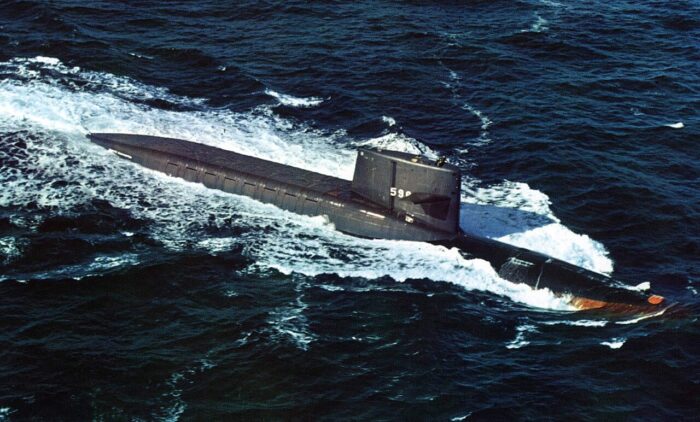
“The Georgefish” was commissioned on 30 December 1959 as SSBN-598, captained by James B. Osborn in command (Blue crew), Commander John L. From, Jr. (Gold crew). Another submarine under construction at the time received the original name and hull number of the one she replaced. As her ballistic missile compartment design was intended to be reused in other ship classes, the section inserted had a deeper test depth rating than the rest. She left Groton on 28 June 1960 for Cape Canaveral with two Polaris missiles and went to the Atlantic Missile Test Range with Rear Admiral William Raborn on board as observer, to make the first successful first Polaris missile launch on 20 July 1960. The latter hit the impact area 1,100 nmi (1,300 mi; 2,000 km) downrange as planned.
She then sailed with Gold crew and by 30 July 1960 launched two more missiles the completed her Shakedown on 30 August, then sailed back again on 28 October for Naval Weapons Station Charleston and load her 16 Polaris missiles, earning a Navy Unit Commendation, and embarked Blue crew for this deterrent patrol of 66 days.
The patrol was done all submerged until 21 January 1961, before she headed back to Naval Submarine Base New London and embarked the Gold crew starting her next patrol on 14 February 1961, crossing the Atlantic and entering the Holy Loch, Scotland, on 25 April 1961.
The rest of the decade was made in yearly patrols, generally two per year alternating crews, and in 1970 she had her core refuelled in Charleston SC after 100,000 nmi (120,000 mi; 190,000 km).
On 9 April 1981 when cruising at periscope depth she was broadsided by the 2,350 long tons (2,390 t) Japanese commercial cargo ship Nissho Maru while in the East China Sea, 110 nmi (130 mi; 200 km) DW of Sasebo. She surfaced and searched for her in heavy fog and saw Nissho Maru appeared undamaged and went to port for repairs. She had been reassigned to the Pacificfleet and operated from Pearl Harbor. Unlike what the captain believed, the Japanese cargo sank in 15 minutes, with 2 sailors lost, 13 rescued by JDS Akigumo (DD-120) and Aogumo. Herself only had minor damage to her sail.
This angered Japanese authorities at the time, but the crisis was defused. As why the SSBN was so close to Japan, plausable deniability was used.
G. Washington’s damaged sail was repaired with parts from USS Abraham Lincoln’s waiting for disposal at Puget Sound.
She made her final patrol from Pearl later in 1981 and sailed home at her return to unload her missiles at Bangor, Washington under SALT II treaty. In all she had performed 55 deterrent patrols, first in the Atlantic, then Pacific oceans over 25-year career and was reclassified an attack submarine (SSN) at Pearl Harbor. But her slow speed meant she had little value in this role. In 1983, she made her last patrol from Pearl Harbor, transited Panama to the Atlantic, New London at the SSBN Submarine Base Groton. She took part in exercises with a Coast Guard Cutter against USS John F. Kennedy (CV-67) carrying CAG 4. Later she was off Puerto Rico, Roosevelt Roads NS to support Special Forces training, and the 24th UNITAS, notably training with Chile and completing a circumnavigation while escorting John F. Kennedy not far from the Falkland Islands in 1984. She was decommissioned on 24 January 1985, stricken on 30 April 1986, and disposed via the Ship-Submarine Recycling Program at Puget Sound Naval until 30 September 1998.
 Patrick Henry (SSBN-599)
Patrick Henry (SSBN-599)
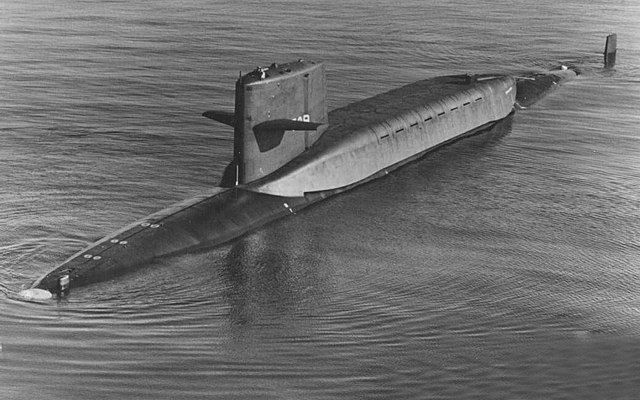
USS Patrick Henry was laid down at Electric Boat, Groton, on 26 May 1958, launched on 22 September 1959, and commissioned on 9 April 1960, under Captain Harold E. Shear (Blue crew), Commander Robert L. J. Long (Gold crew), making her shakedown with the Blue crew until 16 September 1960, then Gold crew and first deterrent patrol from December 1960 (Blue) surfacing off Holy Loch, Scotland on 8 March 1961, a submerged cruise record of 66 days and 22 hours and being the first ballistic missile submarine to enter Holy Loch. She went close to USS Proteus for R&R.
She made 17 deterrent patrols from Holy Loch until December 1964 and had a 18 months overhaul at Groton, including S5W refreshing and installation of the Polaris A-3. After shakedown off Puerto Rico and Cape Canaveral she departed Charleston for her 18th patrol in SubRon 14. On 1 March 1968 she made her 22nd patrol at Holy Loch.
In 1976, she was reassigned to Vallejo, California, for core refueling. In the spring 1978, she made a Demonstration and Shakedown Operations (DASO) confirmi er SLBM launch capavilities at all timeswhile system performance data was collected. She fired an A-3 Polaris off Cape Kennedy in July 1978, Gold Crew made another weeks later and she transited to Pearl Harbor, remained there with into the 1980s and by 1982 she had her silos disabled and became SSN-599 until decommissioned and struck on 25 May 1984, starting her disposal from 21 August 1997 through the Ship-Submarine recycling program at Puget Sound.
 Theodore Roosevelt (SSBN-600)
Theodore Roosevelt (SSBN-600)
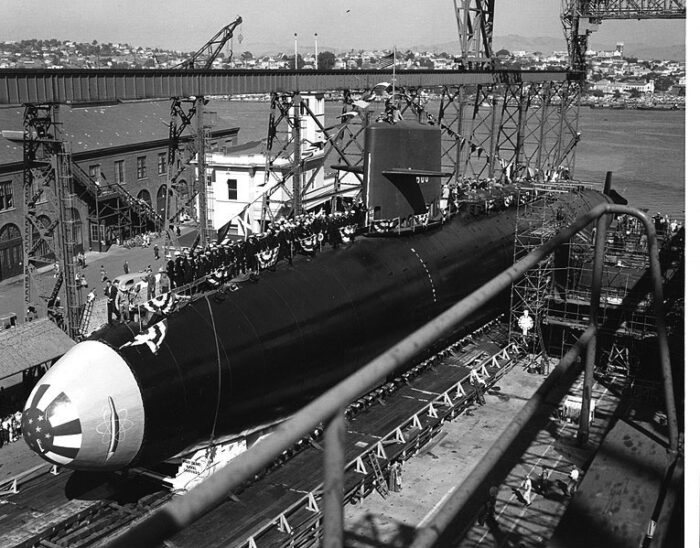
USS “Teddy” had her keel was laid down on 20 May 1958 at Mare Island Shipyard using USS Scamp (SSN-588) previous material, redesignated SSBN-600 and renamed on 6 November 1958, launched on 3 October 1959 (sponsored by the daughter of Theodore Roosevelt) commissioned on 13 February 1961. Her first two captains were William E. Sims (Blue) and Oliver H. Perry, Jr. (yes, this one) for Gold Crew. She sailed for her shakedown on 18 February 1961 for the East Coast via Panama and transited on 7 March. On 11 March she was off Cape Canaveral for her first Polaris launch on the 20th, completing her shakedown. In Groton she had her usual post-shakedown fixes at Electric Boat and on 24 June 1961 departed for Charleston via Norfolk, Virginia. She loaded her missiles on 7-19 July at the Naval Ammunition Depot in Charleston and sailed on for her first deterrent patrol until 23 September at Holy Lochd.
She made 15 more deterrent patrols from Holy Loch and in the spring of 1965, made her 17th and final patrol to and from Holy Loch back to Charleston on 15 June 1965, uloading her 16 Polaris missiles and headed for New London shipyard for an extensive overhaul.
Until January 1967 she notably her her reactor core refueled and Polaris A3 installed. She departed for trials on 14 January 1967 and launch her first Polaris A3 off Cape Canaveral at the missile range late April 1967. In Charleston she loaded all her missiles adn sailed to Holy Loch and 18th patrol on 1 June 1967 until February 1968 making her 18,20 and 21st patrols. On 20 March 1968 she ran aground off the western coast of Scotland, and was repaired in drydock and departed on 5 April for permanent repairs after unloading her missiles in New London. This was completed by mid-October 1968. After sea trials she left New London on 2 November for post-repair shakedown via Norfolk, Puerto Rico, St. Croix (Virgin Islands) and back to Charleston on 27 November 1968. She was back at Holy Loch in 1969, making 9 more patrols until May 1971.
On 12 May 1971, she made the 31st patrol of her career and by 20 July she was back in New London, both crews gathered for her overhaul and many reassigned. In August she started a refit for spec ops until 11 September, operating from Charleston. Later she started her refueling overhaul over two years until January 1974. After sea trials and shakedown in April-May she embarked mishipmen from the Naval Academy and made nuclear propulsion safety training at Norfolk. In mid-June she was reassigned to the Pacific Fleet, Pearl Harbor like her sisters. She made anotther NROTC cruise in July-September and departed Charleston on 20 September for Panama and arrived at Strategic Weapons Facility Bangor to load her missiles, and arrived at Pearl on 4 November. On the 10th she started her move to the Mariana Islands, Guam for a refit and first deterrent patrol from 31 December. She made several patrols from Apra Harbor supported by USS Proteus (AS-19) and her last on 9 October 1978 ending in Pearl Harbor.
A new crew was formed from Blue and Gold crews. From November 1978 until October 1979 she became a “target of opportunity” for ASW training. On 16 October 1979, she headed for San Diego, then Alameda and from 7 November, sailed to Esquimalt in British Columbia, on the 14th she arrived at Carr Inlet, Washington, for acoustic testing, suspended on cables. On 19 November she went to Bangor at the Trident Refit Facility and on 1 December she became the first Fleet Ballistic Missile Submarine offloading her A-3 Missiles at the new Handling Wharf and ended her service with a deactivation crew of 12 officers and 111 ratings from 3 January 1980 at Bangor.
Next she moved to Puget Sound for drydocking with Abraham Lincoln, reactor fuel removed, missile compartment dismantled under SALT and she was undocked, moved pier-side for a formal decommissioning ceremony on 28 February 1981. She was stricken in 1982 and remained in afloat storage for 13 years until 1993, then entering the Nuclear Power Ship and Submarine Recycling Program completed by 24 March 1995.
 Robert E. Lee (SSBN-601)
Robert E. Lee (SSBN-601)
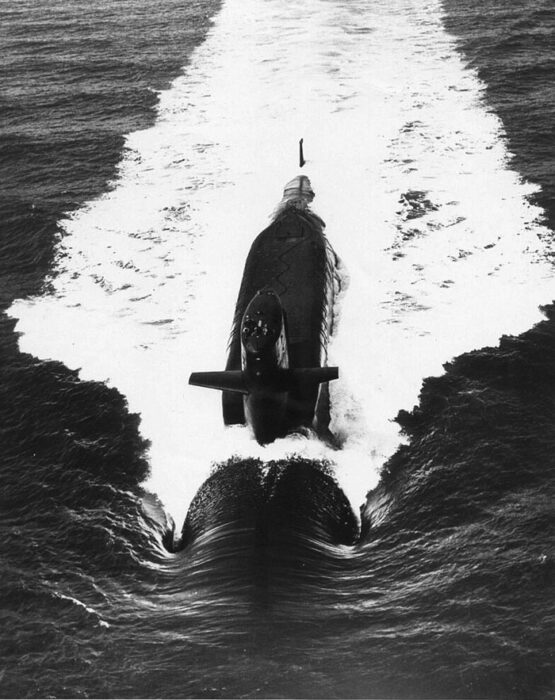
She was laid down on 25 August 1958 at Newport News in Virginia, launched on 18 December 1959, commissioned on 16 September 1960 under Reuben F. Woodal (Blue) and Joseph Williams, Jr. (Gold).
She started her trials and shakedown as the third SSBN, HP Newport News until 2 December 1960, and moved to Narragansett Bay torpedo range, launched five torpedoes on 6 December 1960 and moved to Cape Canaveral, loaded and fired a Polaris on 22 December 1960. By January 1961 she made additional simulated missile launches and departed for Bermuda on 15 January with USS Torsk (SS-423) for ASW training and back to Norfolk on 30 January for shipyard work. On 17 March 1961 she loaded torpedoes at Yorktown and was at Cape Canaveral on 9 April 1961 to load all her missiles and after special operations in May-Juneshe moved for Holy Loch, SubRon 14, arriving on 10 July.
 Starting 9 August 1961 she made 9 deterrent patrol in 1961-63 and by 10 September 1963, she was in the floating drydock Los Alamos (AFDB-7) for refit, and made her 16th between 27 November 1964 until 28 January 1965, entering Mare Island in Vallejo for her major overhaul, core change, missile change (A3), full modernization of navigation, weapons system after 2.5 years starting trials on 12 July 1966. On 5 August she was in San Diego for a five-day visit and on the East Coast on 10 August, transiting the Panama Canal for Charlesto and until October she trained off Cape Canaveral, at some point ambarking the Undersecretary of the Navy on board as an observer for a Polaris A-3 launch and back to Charleston for predeployment upkeep at the Cooper River site with replacement of a failed rudder ram bolt. 4 December was the start of her 17th deterrent patrol ending at Holy Loch on 30 January 1967 and three more patrols.
Starting 9 August 1961 she made 9 deterrent patrol in 1961-63 and by 10 September 1963, she was in the floating drydock Los Alamos (AFDB-7) for refit, and made her 16th between 27 November 1964 until 28 January 1965, entering Mare Island in Vallejo for her major overhaul, core change, missile change (A3), full modernization of navigation, weapons system after 2.5 years starting trials on 12 July 1966. On 5 August she was in San Diego for a five-day visit and on the East Coast on 10 August, transiting the Panama Canal for Charlesto and until October she trained off Cape Canaveral, at some point ambarking the Undersecretary of the Navy on board as an observer for a Polaris A-3 launch and back to Charleston for predeployment upkeep at the Cooper River site with replacement of a failed rudder ram bolt. 4 December was the start of her 17th deterrent patrol ending at Holy Loch on 30 January 1967 and three more patrols.
In November she had performed her 21st patrol before drydocking. She served with SubRon 14 until 1970, completing her 33rd patrol on 1 January 1971 and having her second refit from 27 January 1971 at Puget Sound until 11 December 1971. After post-overhaul trials and exercises on the West Coast she transited Panama to Charleston on 14 September 1972 and wint on with patrols on the East Coast into 1973, retransiting Panama in August 1973 for San Diego, Pearl Harbor, by September 1973 as new HP, and then Apra, Guam, for pacific patorls until 1977. She had third major refit in 1977-1978 at Mare Island with sea trials from August 1978 and retransiting Panama by January 1979 to San Diego and Honolulu for an exchange Gold/Blue Crew. In 1982-1983 her missiles were unloaded, she became SSN 601 and she was decommissioned on 1 December 1983, stricken on 30 April 1986, staying at Puget Sound until enterinh the Nuclear Powered Ship and Submarine Recycling Program. On 30 September 1991 the process was completed.
 Abraham Lincoln (SSBN-602)
Abraham Lincoln (SSBN-602)
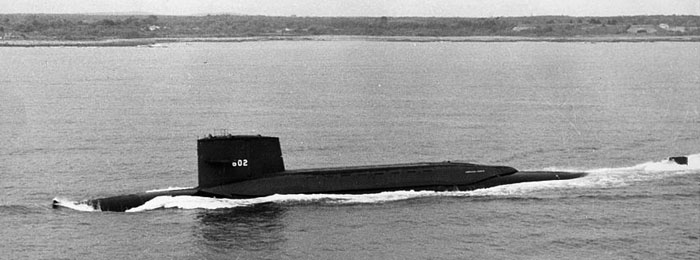
Lincln was was laid down at Portsmouth Naval Shipyard in Kittery, Maine, on 1 November 1958. She was launched on 14 May 1960, commissioned on 8 March 1961 under Leonard Erb (blue) and Donald M. Miller (Gold). She started her shakedown on 20 March 1961 off Cape Canaveral, Portsmouth on 1 June for fixes, and left on 17 July for tests at Cape Canaveral and moved for Charleston to load missiles and sailed on 28 August to join SUBRON 14 at Holy Loch by October. After a short refit with USS Proteus in Novembershe started her first deterrent patrol, making many in four years. She took part also in the Cuban Missile Crisis by October 1962, which caught her in a four-week upkeep and made a 65-day patrol.
On 13 October 1965 she had her first major overhaul at Groton from 25 October 1965 to 3 June 1967, and bacl to Holy Loch, changing tenders to USS Simon Lake and USS Canopus until 1972.
By March she sailed back to Naval Submarine Base New London, Groton for refit, two short training cruises before and on 19 May transited to the West Coast via Fort Lauderdale, Panama and sailed to Bangor to offload her missiles, then San Francisco, Mare Island for overhaul and refueling until December 1973.
After shakedown off San Diego she transited back Panama Canal on 1 June 1974 for tests off Cape Canaveral and Charleston and back via Panama again on 26 July 1974 to her new HP Pearl Harbor on 10 September, SubRon 15 and advanced base Guam on 18 October. Deterrent patrols from the Mariana went on until 1978, interrupted by tests and exercises. She also became the first SSBN making 50 strategic deterrent patrols. She made her last in October 1979 and proceeded to Bangor, Washington, on 30 October 1979 to offload missiles and her inactivation overhaul through 1980 and 1981.
Officially decommissioned on 28 February, stricken on 1 December 1982 she went through the Submarine Recycling Program until 10 May 1994 at Puget Sound.
Read More/Src
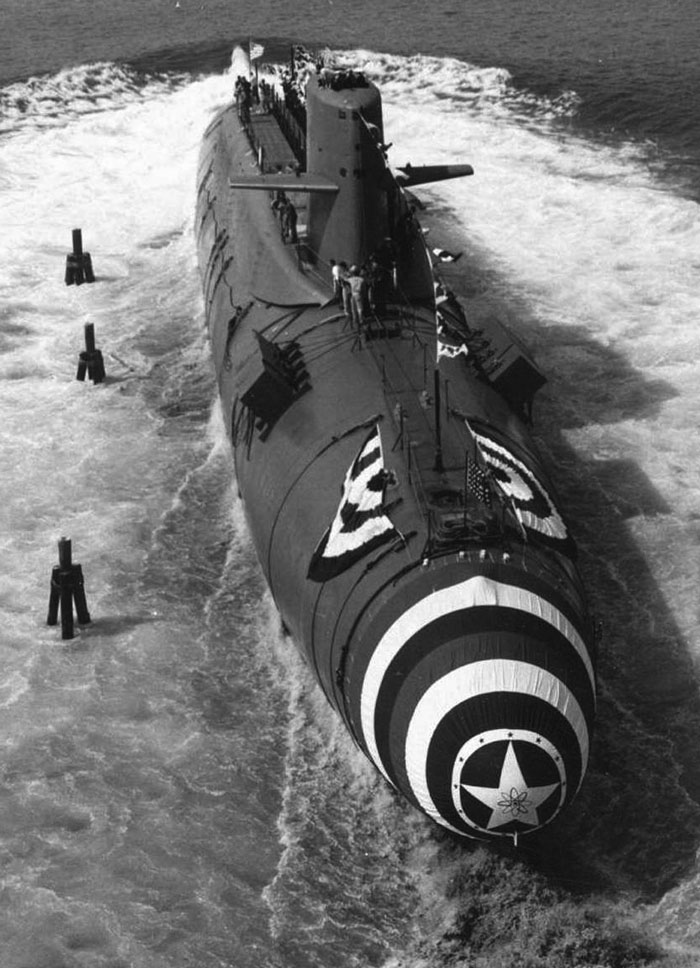
Books
Adcock, Al. U.S. Ballistic Missile Submarines (Carrolltown, Texas: Squadron Signal, 1993), p. 12.
Bauer, K. Jack; Roberts, Stephen S. (1991). Register of Ships of the U.S. Navy, 1775-1990: Major Combatants. Greenwood.
Public Domain This article incorporates text from the public domain Dictionary of American Naval Fighting Ships.
Gardiner, Robert and Chumbley, Stephen, Conway’s All the World’s Fighting Ships 1947–1995, Conway.
Polmar, Norman; Moore, K. J. (2003). Cold War Submarines: The Design and Construction of U.S. and Soviet Submarines. Potomac.
Links
www.history.navy.mil/ ssbn-598.html
navypedia.org/
UGM-27_Polaris
nuke.fas.org/ ssbn-598.htm
weaponsandwarfare.com/ us-navy-hunter-killer-submarines/
usni.org/ historic-fleets
history.navy.mil/ ssbn-598.html
W47
militaryhistory.about.com Ssbn-598.htm
navsource.org/
news.google.com 1st polaris launch scotland
navy.mil/ chrono.html
tapatalk.com/ t45224-s20.html
George_Washington-class_submarine
commons.wikimedia.org/ George_Washington_class_submarines
Videos
video launch footage
1960-11-17_Nuclear_Navy 1st polaris launch


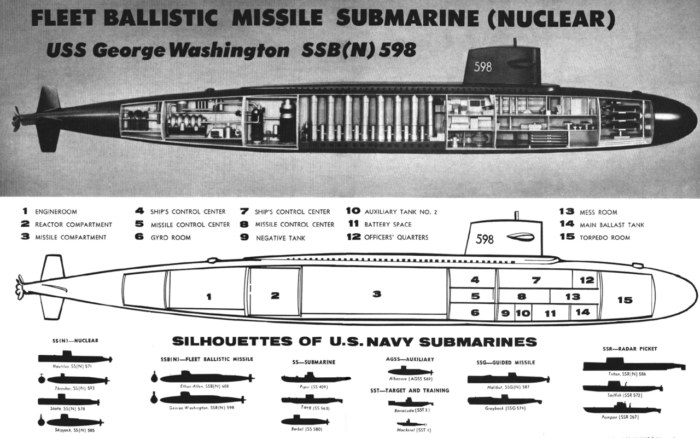

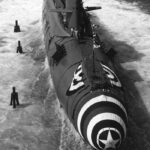
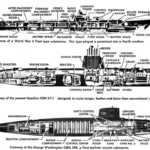
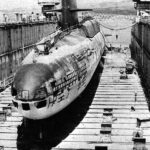
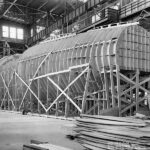
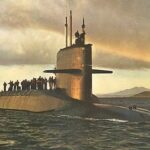
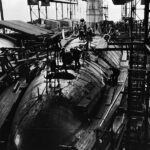
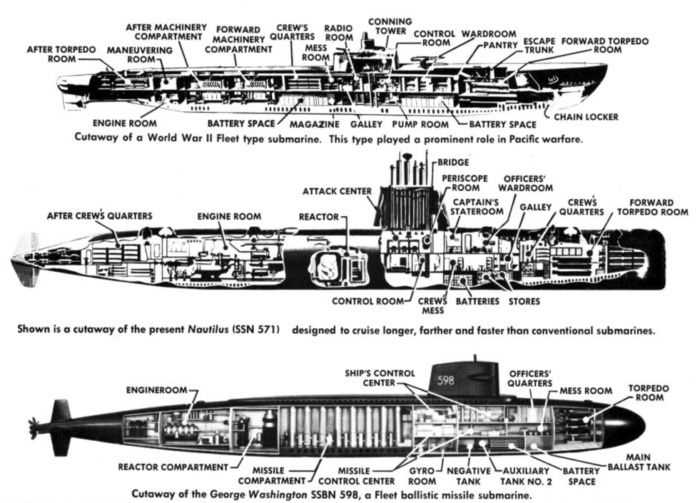
 Latest Facebook Entry -
Latest Facebook Entry -  X(Tweeter) Naval Encyclopedia's deck archive
X(Tweeter) Naval Encyclopedia's deck archive Instagram (@navalencyc)
Instagram (@navalencyc)





 French Navy
French Navy Royal Navy
Royal Navy Russian Navy
Russian Navy Armada Espanola
Armada Espanola Austrian Navy
Austrian Navy K.u.K. Kriegsmarine
K.u.K. Kriegsmarine Dansk Marine
Dansk Marine Nautiko Hellenon
Nautiko Hellenon Koninklije Marine 1870
Koninklije Marine 1870 Marinha do Brasil
Marinha do Brasil Osmanlı Donanması
Osmanlı Donanması Marina Do Peru
Marina Do Peru Marinha do Portugal
Marinha do Portugal Regia Marina 1870
Regia Marina 1870 Nihhon Kaigun 1870
Nihhon Kaigun 1870 Preußische Marine 1870
Preußische Marine 1870 Russkiy Flot 1870
Russkiy Flot 1870 Svenska marinen
Svenska marinen Søværnet
Søværnet Union Navy
Union Navy Confederate Navy
Confederate Navy Armada de Argentina
Armada de Argentina Imperial Chinese Navy
Imperial Chinese Navy Marinha do Portugal
Marinha do Portugal Mexico
Mexico Kaiserliche Marine
Kaiserliche Marine 1898 US Navy
1898 US Navy Sovietskiy Flot
Sovietskiy Flot Royal Canadian Navy
Royal Canadian Navy Royal Australian Navy
Royal Australian Navy RNZN Fleet
RNZN Fleet Chinese Navy 1937
Chinese Navy 1937 Kriegsmarine
Kriegsmarine Chilean Navy
Chilean Navy Danish Navy
Danish Navy Finnish Navy
Finnish Navy Hellenic Navy
Hellenic Navy Polish Navy
Polish Navy Romanian Navy
Romanian Navy Turkish Navy
Turkish Navy Royal Yugoslav Navy
Royal Yugoslav Navy Royal Thai Navy
Royal Thai Navy Minor Navies
Minor Navies Albania
Albania Austria
Austria Belgium
Belgium Columbia
Columbia Costa Rica
Costa Rica Cuba
Cuba Czechoslovakia
Czechoslovakia Dominican Republic
Dominican Republic Haiti
Haiti Hungary
Hungary Honduras
Honduras Estonia
Estonia Iceland
Iceland Eire
Eire Equador
Equador Iran
Iran Iraq
Iraq Latvia
Latvia Liberia
Liberia Lithuania
Lithuania Mandchukuo
Mandchukuo Morocco
Morocco Nicaragua
Nicaragua Persia
Persia San Salvador
San Salvador Sarawak
Sarawak Uruguay
Uruguay Venezuela
Venezuela Zanzibar
Zanzibar Warsaw Pact Navies
Warsaw Pact Navies Bulgaria
Bulgaria Hungary
Hungary

 Bundesmarine
Bundesmarine Dutch Navy
Dutch Navy Hellenic Navy
Hellenic Navy Marina Militare
Marina Militare Yugoslav Navy
Yugoslav Navy Chinese Navy
Chinese Navy Indian Navy
Indian Navy Indonesian Navy
Indonesian Navy JMSDF
JMSDF North Korean Navy
North Korean Navy Pakistani Navy
Pakistani Navy Philippines Navy
Philippines Navy ROKN
ROKN Rep. of Singapore Navy
Rep. of Singapore Navy Taiwanese Navy
Taiwanese Navy IDF Navy
IDF Navy Saudi Navy
Saudi Navy Royal New Zealand Navy
Royal New Zealand Navy Egyptian Navy
Egyptian Navy South African Navy
South African Navy






























 Ukrainian Navy
Ukrainian Navy dbodesign
dbodesign